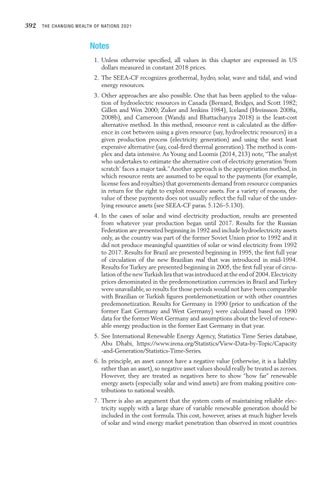392
T H E C H A N G I N G W E A LTH O F N ATIO N S 2021
Notes 1. Unless otherwise specified, all values in this chapter are expressed in US dollars measured in constant 2018 prices. 2. The SEEA-CF recognizes geothermal, hydro, solar, wave and tidal, and wind energy resources. 3. Other approaches are also possible. One that has been applied to the valuation of hydroelectric resources in Canada (Bernard, Bridges, and Scott 1982; Gillen and Wen 2000; Zuker and Jenkins 1984), Iceland (Hreinsson 2008a, 2008b), and Cameroon (Wandji and Bhattacharyya 2018) is the least-cost alternative method. In this method, resource rent is calculated as the difference in cost between using a given resource (say, hydroelectric resources) in a given production process (electricity generation) and using the next least expensive alternative (say, coal-fired thermal generation). The method is complex and data intensive. As Young and Loomis (2014, 213) note, “The analyst who undertakes to estimate the alternative cost of electricity generation ‘from scratch’ faces a major task.” Another approach is the appropriation method, in which resource rents are assumed to be equal to the payments (for example, license fees and royalties) that governments demand from resource companies in return for the right to exploit resource assets. For a variety of reasons, the value of these payments does not usually reflect the full value of the underlying resource assets (see SEEA-CF paras. 5.126–5.130). 4. In the cases of solar and wind electricity production, results are presented from whatever year production began until 2017. Results for the Russian Federation are presented beginning in 1992 and include hydroelectricity assets only, as the country was part of the former Soviet Union prior to 1992 and it did not produce meaningful quantities of solar or wind electricity from 1992 to 2017. Results for Brazil are presented beginning in 1995, the first full year of circulation of the new Brazilian real that was introduced in mid-1994. Results for Turkey are presented beginning in 2005, the first full year of circulation of the new Turkish lira that was introduced at the end of 2004. Electricity prices denominated in the predemonetization currencies in Brazil and Turkey were unavailable, so results for those periods would not have been comparable with Brazilian or Turkish figures postdemonetization or with other countries predemonetization. Results for Germany in 1990 (prior to unification of the former East Germany and West Germany) were calculated based on 1990 data for the former West Germany and assumptions about the level of renewable energy production in the former East Germany in that year. 5. See International Renewable Energy Agency, Statistics Time Series database, Abu Dhabi, https://www.irena.org/Statistics/View-Data-by-Topic/Capacity -and-Generation/Statistics-Time-Series. 6. In principle, an asset cannot have a negative value (otherwise, it is a liability rather than an asset), so negative asset values should really be treated as zeroes. However, they are treated as negatives here to show “how far” renewable energy assets (especially solar and wind assets) are from making positive contributions to national wealth. 7. There is also an argument that the system costs of maintaining reliable electricity supply with a large share of variable renewable generation should be included in the cost formula. This cost, however, arises at much higher levels of solar and wind energy market penetration than observed in most countries


